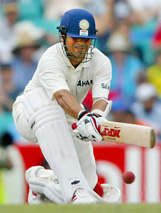COACHING
Cricket and the Tennis elbow-Part I
All the sports headlines these days are screaming that Master Blaster Sachin Tendulkar is out of the game for some time because of injury, which has been diagnosed as tennis elbow. Cricket-lovers in India and elsewhere have been speculating and debating about the exact nature of the injury.What is a tennis elbow, and how is it caused?

Reverse sweeping can cause a tennis elbow
As the name suggests, this particular injury is
found mostly in tennis players, especially those
who hit hard backhand shots and in the process,
sprain the lateral ligament of their elbow. The
chances of suffering this injury increase if the
wrist extensor, triceps or forearm muscles are
weak.
The injury is accompanied with pain and tenderness over the lateral (outer) part of the elbow, medically termed as lateral epicondylitis i.e inflammation of radiohumeral ligament. The pain usually begins after forceful or repetitive motions of wrist extension.
In the acute (initial) phase, a tennis elbow causes intense pain and prevents any sports activity. The mere lifting of a cup or even a gentle handshake can be painful, so there is no question of lifting of a heavy bat. In fact it can seriously aggravate the condition, if not treated and rested properly. The ache may subside with rest and icing, only to reappear with greater severity if the arm and wrist continue to be actively used, until the pain and tenderness is constant and disabling.
The injury is accompanied with pain and tenderness over the lateral (outer) part of the elbow, medically termed as lateral epicondylitis i.e inflammation of radiohumeral ligament. The pain usually begins after forceful or repetitive motions of wrist extension.
In the acute (initial) phase, a tennis elbow causes intense pain and prevents any sports activity. The mere lifting of a cup or even a gentle handshake can be painful, so there is no question of lifting of a heavy bat. In fact it can seriously aggravate the condition, if not treated and rested properly. The ache may subside with rest and icing, only to reappear with greater severity if the arm and wrist continue to be actively used, until the pain and tenderness is constant and disabling.
In the 'chronic' (latter) phase, a tennis elbow develops over a period of time after initial symptoms of the conditions have been ignored and not treated. Unlike the acute phase, mere rest cannot heal the injury. The pain is often steady and recurrent, so the symptoms may last for longer durations like weeks or months.
Cricketers are also susceptible to a tennis elbow, as we are all aware. It can occur due to:
1- Throwing: a flat-arm throw with a great thrust which a player normally does while fielding in the 30-yards circle at point, short cover, short mid-wicket, or square-leg. If the player has a weak wrist, forearm or triceps, he can sustain this injury.
2- The bat and handle: Using a heavy bat despite your arm and wrists not having the corresponding strength. A heavy bat may put too much strain while playing strokes in quick succession and may cause tennis elbow. The next thing to be considered is the size of the handle, which must be correct. A handle that is too thick or too thin handle calls for greater strength to play different shots, and thereby increases the danger of overstressing the muscles while swinging the arm.
3- The weight of the cricket ball: Nowadays, players try to practise with different balls in the rainy season. This is something that is commonly seen in Mumbai, where they practise with a rubber ball or with the ball used in bowling machines. The weights of these balls differ from the normal cricket ball. What could happen is that a batsman while practising with a rubber ball, which is lighter than a cricket ball, will apply greater force while trying to hit it. More force means more pressure, more pressure means more stress on the joint, and more stress means injury if your muscles are weak.
4- Playing shots: Trying to flick the ball using more of the wrist muscles or trying to hit the ball with a horizontal bat may give rise to this injury, if the forearm and wrist muscles are weak. A reverse sweep with a jerky movement can give a thrust to the elbow, which can sprain the lateral ligament. Digging out a yorker can also put a lot of pressure on the elbow.
The treatment of a tennis elbow in the acute and chronic phase will be discussed in the next article.